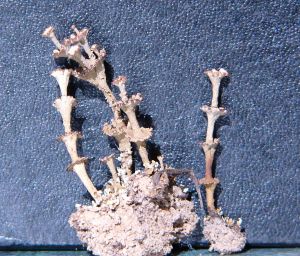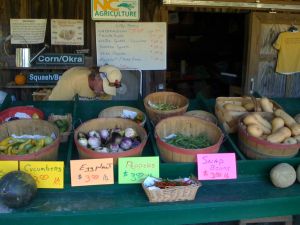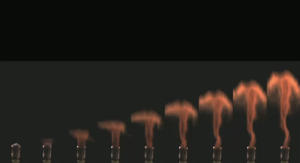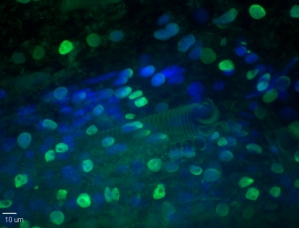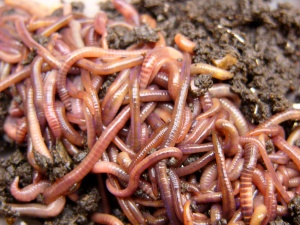 © 2010 Sharon Settlage. All rights reserved.
© 2010 Sharon Settlage. All rights reserved.
Growing Red Wiggler Worms for Composting – Local Raleigh readers: pick up the March/April issue of Triangle Gardening to see my article on worm composting, with quotes from Susan Quinby-Honer–Raleigh’s original “worm lady” and owner of Red hen Enterprises.
Worms are kept in a 10 gallon Rubbermaid container with 1/8 inch holes drilled into the sides and bottom. This container is placed into another 10 gallon Rubbermaid that contains a layer of newspaper. The lower container will catch the leachate, or the liquid that drains from the composting process. About once per week check the lower bin for escaped worms and drain out the liquid.
The worm bin is made in layers:
- About 2 inches of shredded newspaper and/or cardboard
- Worms, starter compost and rotting vegetables
- About 2 or 3 inches of shredded newspaper and/or cardboard on top.
When adding food, pull back the upper layer of newspaper, put in the food and return the covering newspaper.
At the beginning, add food to one side of the bin only, that way you can see how fast the worms are eating the food. Keep adding food to the one side until it is full, then start adding food to the other side. The worms will move out of the finished food into the new food.
Things to put in the bin:
Any vegetable or fruit
Coffee grounds, tea bags
Paper towels
Dog hair
Shredded newspaper
Shredded cardboard
Stale bread
Non-greasy left-overs
No meat
The finished worm castings are great fertilizer for your garden. Also try making worm tea as a fertilizer and spray to kill bugs on plants in the garden.
I copied this recipe for tea from the Internet:
(http://www.yelmworms.com/Newsletters/June%202006%20Newsletter.htm)
Worm Tea Recipe
In our last newsletter we talked about the whats, whys, and hows of worm tea. Here is a recipe for you to brew your own:
8-10 cups Earthworm Castings
¼ cup sulfur free molasses
4+ gallons Chlorine free water
(Note: If you have chlorinated water, fill your pail and let it sit overnight uncovered, and the chlorine will evaporate. Alternatively, accelerate the process by putting the water in your brewer and turning the bubbler on. You will know the chlorine is gone when you cannot smell the chlorine anymore – probably in as short a time as 20-30 minutes. You can verify the absence of chlorine by purchasing a simple chlorine test kit from a local pool supplier.)
Tea Brewer components:
Min. 5 gallon plastic pail
Air pump with air stone or some other air dispersal device.
(can buy in aquarium dept at Walmart)
Sieve (a paint filter will do)
First, ensure that all components are clean and there are no buildups or areas of your brewer that will prevent the circulation of air and water.
In a 5 gallon pail, fill with 4 gallons or so of warm water with the molasses. Place the airstone or other bubbler at the bottom of the pail and turn it on. For best results, open brew by placing the Earthworm Castings directly into the water. (You can strain the castings later if you are going to use a sprayer for worm tea application.) Alternatively, place the Earthworm Castings into a filter and place into the pail over the bubbler.
Brew until a noticeable frothy slime (“bio-slime”) develops on the surface of the water and the smell of the ingredients is no longer present. The absence of molasses odor indicates that the microorganisms have consumed the ingredients! Once the food is gone, populations will begin to decrease. On these warm summer days, you can begin a brew in the evening, and the tea will be ready for application the next morning. We find brewing is complete in as little as 12 hours if the brew is kept warm. However, brew times are heavily dependent on the water temperature. With every 10 degree F drop in temperature, brew times increase by 12 hours.
Be sure to keep the tea aerobic by leaving the bubbler on until you use the tea.
While brewing, the population of beneficial microorganisms are doubling in as little as 20 minutes. By the end of the brew, your solution can contain over one billion little critters per teaspoon of tea!
Apply the tea when the populations of microorganisms are at their largest numbers. Spray the tea onto foliage, stems, roots and surrounding soil, or simply pour it onto you plants and vegetation. Remember, Worm Tea Everything! Spray early morning or in the evening or in the shade, not in the sunshine.
When you are finished, use the castings for your soil amendment needs. Do not discard them! These castings should have higher population densities than what you started with, because remember, you brewed an exceedingly large population, and they will adhere to the castings!
Websites:
http://www.wikihow.com/Make-Your-Own-Worm-Compost-System
http://www.redwormcomposting.com/
 If you like this post please leave a comment!
If you like this post please leave a comment!
Thank you for viewing!
